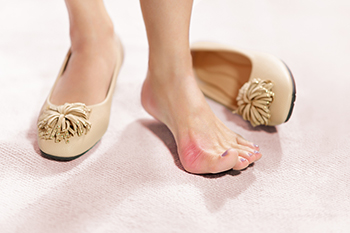 Bunions are bony bumps that form at the base of the big toe, causing the toe to deviate toward the others. They develop due to prolonged pressure on the joint, often from wearing tight or ill-fitting shoes. Genetics, arthritis, and foot injuries can also contribute to their formation. Symptoms include a visible bump, swelling, redness, and pain around the affected joint. Over time, bunions can lead to difficulty in walking, as they cause misalignment of the toes and increase pressure on the ball of the foot. This can result in discomfort, a limited range of motion, and changes in gait. Relief options include wearing wider shoes, using orthotic devices, and taking anti-inflammatory medications. In severe cases, surgery may be necessary to realign the bones. If you have persistent or worsening symptoms from your bunion, it is suggested that you visit a chiropodist for a comprehensive evaluation and a personalized treatment plan.
Bunions are bony bumps that form at the base of the big toe, causing the toe to deviate toward the others. They develop due to prolonged pressure on the joint, often from wearing tight or ill-fitting shoes. Genetics, arthritis, and foot injuries can also contribute to their formation. Symptoms include a visible bump, swelling, redness, and pain around the affected joint. Over time, bunions can lead to difficulty in walking, as they cause misalignment of the toes and increase pressure on the ball of the foot. This can result in discomfort, a limited range of motion, and changes in gait. Relief options include wearing wider shoes, using orthotic devices, and taking anti-inflammatory medications. In severe cases, surgery may be necessary to realign the bones. If you have persistent or worsening symptoms from your bunion, it is suggested that you visit a chiropodist for a comprehensive evaluation and a personalized treatment plan.
Bunions progressively worsen over time and may cause walking in your shoes to become difficult. To learn more about bunions, please consult with one of the chiropodists from Complete Family Footcare & Therapy. Our clinicians will assess your condition and provide you with quality foot and ankle treatment.
What Are Bunions?
A bunion is a bony bump that protrudes from the base of the big toe. Bunions are caused due to a misalignment of the first metatarsal. The characteristic bump of a bunion forms when the metatarsal shifts outwards from its proper position. Bunions develop slowly over time and progressively worsen without treatment. The skin over the bunion may develop calluses due to the friction from shoes. Eventually, a bunion can make walking uncomfortable or even painful. Bunions are one of the most common foot deformities and are especially common in women and older adults.
Symptoms
A bunion appears as a bulging bump on the outside of the base of the big toe.
The bunion may also:
Be swollen, red, or sore
Develop corns or calluses over it
Cause pain
Limit the big toe’s range of motion
Treatment
There are several different treatments available for bunions. Conservative treatment options include wearing shoes with a wider toe box, cushioning the bunion with a specialized pad, wearing shoe inserts, icing the bunion if it becomes inflamed, and taking medications to relieve pain. In more severe cases, more invasive procedures may be done. This may involve removing the swollen tissue around the bunion, straightening the big toe, realigning the bones at the front of the foot, or a combination of these procedures.
If you have any questions, please feel free to contact our offices located in . We offer the newest diagnostic and treatment technologies for all your foot care needs
